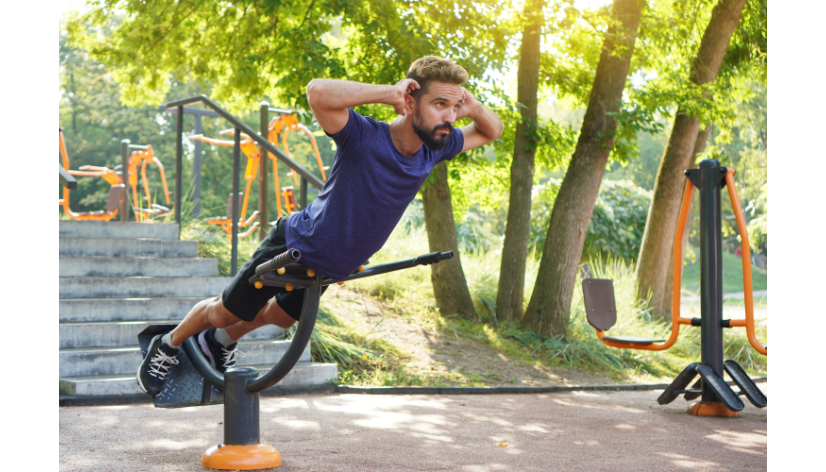Introduction
Welcome, fitness enthusiasts, to a journey of strength and resilience! In the realm of fitness, few things are as impressive as a strong and well-defined back. Not only does it contribute to a powerful physique, but a robust back also plays a pivotal role in everyday activities and overall well-being. In this guide, we’ll delve into the importance of a strong back and provide you with a comprehensive workout routine tailored to help you achieve that Herculean strength.
The Significance of a Strong Back
Before we dive into the workout routine, let’s take a moment to appreciate why a strong back is crucial. Your back muscles are involved in almost every movement you make, from picking up groceries to perfecting your deadlift form at the gym. A strong back not only enhances your posture but also reduces the risk of injuries and promotes overall spinal health.
The Workout Routine
Pull-Ups:

An excellent bodyweight exercise, pull-ups target your upper back, lats, and biceps. . In the event that you’re a novice, begin with helped pull-ups or use obstruction groups to develop fortitude slowly. Incorporate 3 sets of 8-10 pull-ups into your routine, adjusting the difficulty as needed. As you progress, you can experiment with different grip variations to target various muscle groups.
Deadlifts:
Start your back workout with the king of compound exercises – the deadlift. Deadlifts engage multiple muscle groups, including your lower and upper back, making them an essential addition to your routine.
Aim for 3 sets of 8-12 repetitions, gradually increasing the weight as your strength improves. Center around keeping up with legitimate structure to expand the advantages and limit the gamble of injury.
Lat Pulldowns:
Lat pulldowns are an excellent isolation exercise that specifically targets the latissimus dorsi, the broadest muscle of the back. Adjust the cable machine to a suitable weight, sit comfortably, and pull the bar down towards your chest.
Aim for 3 sets of 12-15 repetitions, focusing on the mind-muscle connection. Control the movement to fully engage your lats and achieve optimal results.
Barbell Rows:

Barbell rows are perfect for targeting the middle and upper back muscles. Ensure a stable stance, hinge at the hips, and pull the barbell towards your chest while keeping your back straight.
Include 4 sets of 10-12 repetitions in your workout, progressively increasing the weight. This exercise is effective in building thickness and definition in your back muscles.
Face Pulls:
Don’t neglect your rear delts and upper traps. Face pulls with a cable machine are an effective way to target these muscles, promoting balanced shoulder development and overall back aesthetics.
Integrate 3 sets of 15-20 repetitions into your routine, adjusting the weight to maintain proper form. This exercise is not only great for aesthetics but also contributes to shoulder health.
Hyperextensions:

Finish your workout with hyperextensions to target your lower back muscles and strengthen your posterior chain. Lie face down on a hyperextension bench, engage your lower back muscles, and lift your torso until it’s in line with your legs.
Incorporate 2 sets of 15-20 repetitions to enhance the stability and strength of your lower back.
Tips for Success
Consistency is Key:
Building a strong back takes time and consistency. Stick to your workout routine and progressively challenge yourself by increasing weights or intensity.
Proper Form Over Heavy Weights:
Focus on maintaining proper form during each exercise to prevent injuries and ensure maximum muscle engagement.
Rest and Recovery:
Adequate rest is crucial for muscle recovery. Ensure you get enough sleep and allow your back muscles to recover between workouts.
Nutrition Matters:
Support your strength-building journey with a well-balanced diet rich in protein, vitamins, and minerals. Legitimate nourishment assumes a fundamental part in muscle development and recuperation.
Conclusion
Congratulations on taking the first step toward a stronger, more resilient back! Incorporate this workout routine into your fitness regimen, stay consistent, and witness the transformation of your back into a symbol of strength and power. Remember, fitness is a journey, and with dedication and perseverance, you’ll unlock the full potential of your back muscles, elevating both your physical and mental well-being. Embrace the challenge, stay motivated, and let the strength of your back be a testament to your unwavering commitment to a healthier, more robust you.
FAQs
Q: Can I perform these exercises if I have a history of back pain?
A: If you have a history of back pain or any existing medical conditions, it’s crucial to consult with a healthcare professional or a certified fitness trainer before starting any new exercise routine. They can provide personalized advice and modifications to ensure your safety.
Q: How often should I train my back muscles?
A: The frequency of your back workouts depends on various factors, including your fitness level and overall workout schedule. As a general guideline, aim for 1-2 dedicated back workouts per week, allowing at least 48 hours of rest between sessions to promote optimal recovery.
Q: I find pull-ups challenging. Are there alternative exercises to build back strength?
A: Absolutely! If pull-ups are challenging initially, you can start with assisted pull-ups using a machine or resistance bands. Lat pulldowns and inverted rows are also effective alternatives to gradually build the strength required for pull-ups.
Q: Can I do this workout at home, or do I need a gym membership?
A: While some exercises, like hyperextensions, can be adapted for home workouts, many of the recommended exercises require gym equipment such as barbells, cables, and pull-up bars. If you’re working out at home, consider investing in a set of dumbbells, resistance bands, or a pull-up bar to replicate some of the movements.
Q: How long should each workout session last?
A: The duration of your workout sessions can vary, but a well-rounded back workout typically takes around 45 minutes to an hour. Focus on quality over quantity, ensuring that each exercise is performed with proper form and intensity.
Q: Is it normal to feel sore after a back workout?
A: Yes, it’s normal to experience muscle soreness, especially if you’re challenging your muscles with new exercises or increasing the intensity. This soreness, known as delayed onset muscle soreness (DOMS), is a natural part of the muscle-building process. Adequate rest, hydration, and proper nutrition can help alleviate soreness.
Q: How can I prevent injuries while performing these exercises?
A: To prevent injuries, prioritize proper form over heavy weights. Warm up adequately before each workout, and incorporate dynamic stretches to prepare your muscles. If you’re unsure about your form, consider seeking guidance from a fitness professional or trainer.
Q: Can women benefit from this back workout, or is it tailored specifically for men?
A: This back workout is beneficial for both men and women. The exercises target various muscle groups in the back, promoting strength, posture, and overall well-being. Tailor the weights and intensity to your fitness level, gradually progressing as you gain strength.
